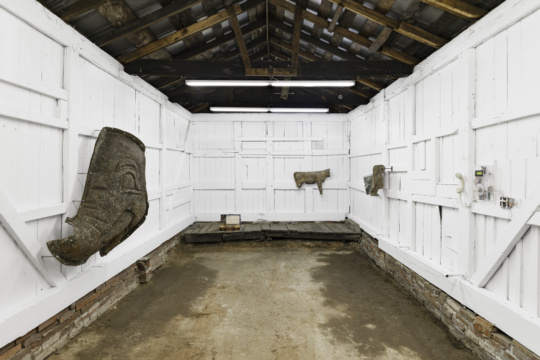
Dear BURNAWAY,
How should I prepare my paintings for a show? I’ll be shipping four paintings to a curator in Philadelphia and want to make her life as easy as possible. What’s the best hanging method to use? Wire, hooks? The pieces are various sizes. Nothing too huge. Thoughts?
Wired in Decatur
Dear Wired,
Very happy to hear about your exhibition! Equally happy to hear that you are thinking about the details already. Hanging hardware can play a very important role in how your work looks when it’s up on the wall, and it’s definitely an aspect that needs serious consideration.
First, I recommend choosing a uniform hanging system (whatever it is) that you can apply to most of your work. The smoother the system, the less you have to think about it, and the more you can think about the work itself! So let’s talk details.
There are numerous approaches to hanging unframed paintings, and each approach can be done poorly or well. For the sake of everyone’s attention span, we’re going to talk about the two most common methods: wiring and D-rings. As I said earlier, each of these can be done really well or really poorly, it’s all about being meticulous and sticking to a steady, solid method.
Wiring is the most traditional way of hanging a work; thus, it’s the one that gets screwed up the most. So let’s talk about that one first.
This process begins with a pair D-rings, which act as anchors for the wire. If it’s a small piece, use a D-ring with one screw, and if it’s larger, use a sturdier D-ring with two screws.
NOTE: You could also use screw eyes here, but those are a bit less reliable and way fussier. They always hurt my fingers when I try to screw them in, so I generally loathe them. I’d say avoid using screw eyes unless you like unnecessarily difficult tasks and are placing them inside the stretcher, as pictured below. (This is typically done for very small works.) If the eyes are sticking out from the back, they can cause the painting to jut out from the wall, which usually looks horrible. Overall, D-rings are more versatile, secure, and easier to work with.
Next, location! Where you place your rings along the stretcher is vital to it hanging properly against the wall.
The general rule of thumb is that you want to place the rings a third of the way down on the painting. So, for example, if you’re painting is 24 inches tall, measure down 8 inches from the top and that’s where you’ll position the rings. Angle them inward at a 45 degree angle. Like so:

Get appropriately thick hanging wire (no fishing line or floral wire!) and measure the wire length so that when you pull up on the center, it’s not too close to the top. To finish it off, wrap each end multiple times around itself. A poorly secured wire will slowly come undone over time. You don’t want that! This, for example, sucks:

In fact, it makes my skin crawl.
But this one, on the other hand, is so perfect all those crawlies melt away into a vast, deep oblivion:

Now THAT is a beautiful wire wrap. If you get anywhere in the ballpark of this one, you’re probably in good shape.
Finally, if you’re wiring anything, buy these rubber bumpers, or some like it, to put on the two bottom corners of the back of the painting. They will correct the angle and make it parallel to the wall. They also help keep work level and prevent it from shifting positions. Secret weapon for many art installers.
Now that we’ve figured out how not to screw up wiring a painting, let’s talk about the simpler method of plain old D-rings. Affixing D-rings to a piece is pretty straightforward. I would probably always go for D-rings if your painting is significantly wide or heavy.
First, use the same one-third-down measuring rule we discussed before. Next, position the rings vertically, close to work’s edge; use the D-rings with two screws so they don’t move around at all. Below is a pretty great example. Obviously this is a framed work, but you can follow the same method on the stretchers for unframed paintings, as well.

Compared to a wired painting, a work prepped with D-rings is just as easy (if not easier) for a curator to install. The only concern would be if the curator is particularly concerned with the number of holes they make in the wall. So, if you want to be extra polite, just ask! If they are required to have as few holes as possible, or maybe the walls are funky, then perhaps they’d prefer one method to the other. D-rings requires two nails in the wall whereas wired paintings often require only one. You’ll also need to measure precisely and use a level to make sure the holes are even.
Whichever method you choose, I wish you the best of luck at the show and I hope you sell everything and get a trillion great reviews. Before sending your work off, be sure to check out my column on shipping artwork for a few pointers on packing it all up!
Got a question for Sara? Send an email to [email protected].
Sara Estes is a writer and curator based in Nashville. She currently works at David Lusk Gallery and is the former gallery coordinator for the Carl Van Vechten and Aaron Douglas Galleries at Fisk University. She is also the apprentice to paintings conservator Cynthia Stow of Cumberland Art Conservation. Estes is the cofounder and curator of the Nashville-based contemporary exhibition space Threesquared. Her writing has been featured in numerous publications, including BURNAWAY, Number, Nashville Scene, Nashville Arts Magazine, ArtsNash, and ArtNow.




